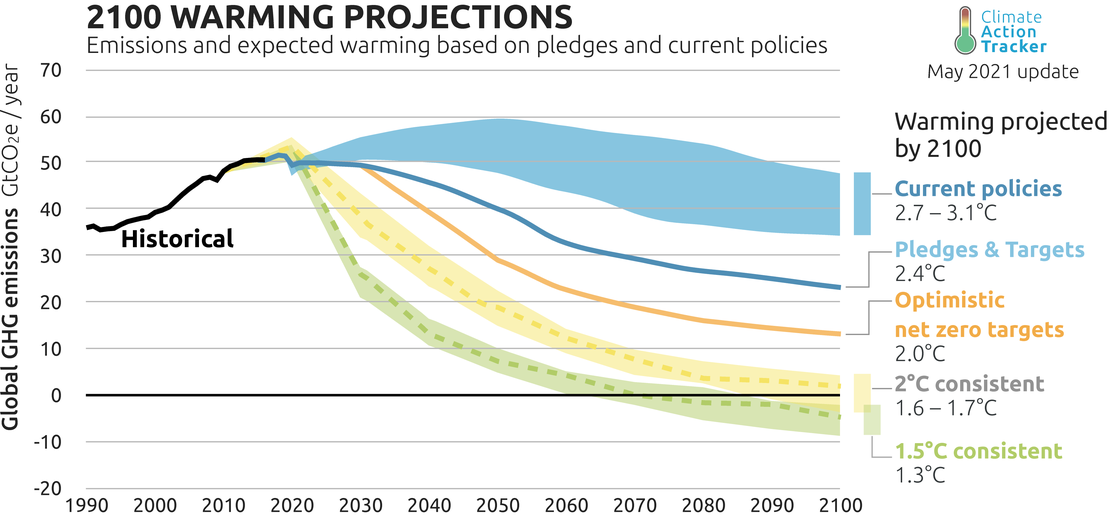Global update: Projected warming from Paris pledges drops to 2.4 degrees after US Summit: analysis
Attachments
Press release
Government announcements of new climate targets have brought down projected end of century warming by 0.2 degrees C, with the projected warming from Paris Agreement pledges now at 2.4˚C, according to new analysis released today by the Climate Action Tracker (CAT).
The projected warming from the “optimistic scenario” assuming full implementation of all net zero targets has dropped to 2.0˚C. While the number of countries adopting or considering net zero targets has risen to 131 countries, covering 73% of global GHG emissions, it is the updated 2030 Paris Agreement 2030 targets, rather than the additional countries, that contribute the most to the drop in projected warming compared with the CAT’s 2.1˚C “optimistic scenario” in the CAT December update.

“It is clear the Paris Agreement is driving change, spurring governments into adopting stronger targets, but there is still some way to go, especially given that most governments don’t yet have policies in place to meet their pledges,” said Bill Hare, CEO of Climate Analytics, one of the CAT partner organisations.
“Our warming estimate from current policies is 2.9˚C - still nearly twice what it should be, and governments must urgently step up their action.”

The biggest contributors to the drop in projected warming are the US, the EU27, China and Japan although China and Japan did not yet formally submit a new 2030 target to the UN. Canada announced a new target, South Africa has an increased target under public consultation, Argentina has announced a further strengthening of the target it submitted last December, and the UK has announced a stronger 2035 target.
While the leaders of India, Indonesia, Mexico, Russia, Saudi Arabia and Turkey all spoke at the US summit, none announced stronger NDCs. South Korea, New Zealand, Bhutan and Bangladesh all committed to submitting stronger NDC’s this year. Australia made a vague commitment to reaching net zero at an unspecified date, but didn’t update its 2030 target. Brazil brought forward its climate neutrality goal, but has changed its baseline, making its 2030 target weaker.
Just over 40% of the countries that have ratified the Paris Agreement, representing about half global emissions and about a third of the global population, have submitted updated NDCs. The CAT’s final calculations on the 2030 emissions gap between Paris pledges and a 1.5˚C pathway show it’s been narrowed by 11-14%.
“The wave towards net zero greenhouse gas emissions is unstoppable. The long-term intentions are good. But only if all governments flip into emergency mode and propose and implement more short-term action, global emissions can still be halved in the next 10 years as required by the Paris Agreement,” said Niklas Höhne of NewClimate Institute, the second CAT partner.
The CAT set out the key measures that governments need to take to get emissions onto a 1.5˚C pathway.
While the renewable electricity and electric vehicle sectors show much promise, and the technology is there, the development of new technologies for the industry and buildings sectors is too slow.
Contrary to the Paris Agreement are the persisting plans of some governments to build new infrastructure such as new coal-fired power plants, increasing uptake of natural gas as a source of electricity and a trend towards larger, less efficient personal vehicles in some countries.
Stay informed
Subscribe to our newsletter